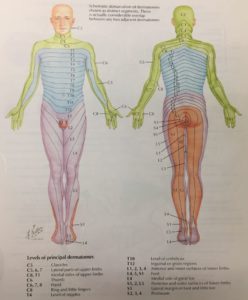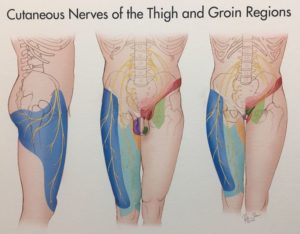Nerve Surgery Heals Patient After Failed Back Surgery

Shelly feels great after peripheral nerve surgeries.*
Shelley is a woman who came to see Dr. Tollestrup after she failed back surgery multiple times. She had pain complaints involving her low back, pelvis, and legs. Before meeting Dr. Tollestrup, Shelly endured failed surgeries and ineffective treatments.
Her story is painful reminder of how getting the right doctor to perform the right surgery is the key to relieving chronic pain.
Painful History
Shelly had three spine surgeries before to coming to see Dr. Tollestrup. After the third surgery, Shelly became aware of severe pain and buzzing in her left leg.
As time progressed the pain in her left foot became worse. Eventually Shelly was given a diagnosis of Chronic Regional Pain Syndrome Type 2 (CRPS II). The assumption was that there had been some type of injury to one or more nerves during the disc replacement surgery.
Shelly tried everything – spine injections, ketamine infusions, various medications, physical therapy and finally a spine stimulator. None of these options gave her relief.
By this time, Shelly’s worst pain was the skin of her left thigh. Shelly’s pain management doctor referred her to a local spine surgeon, who ordered a discogram which was positive at the L3 level. Based on that finding, the spine surgeon recommended a fourth spine surgery which was scheduled for May 1, 2017.
Social Media Leads to a New Option
While waiting to undergo her fourth spine surgery, Shelly discovered Dr. Tollestrup through social media. She made an appointment to see him a month before she was scheduled to have back surgery again.
After putting Shelly through a comprehensive peripheral nerve evaluation, Dr. Tollestrup was able to break down Shelly’s various pain complaints.
Based on his detailed understanding of peripheral nerve anatomy, Dr. Tollestrup knew that the pain in Shelly’s left thigh was not coming from a problem involving her L3 intervertebral disc. The simple reason for this is that Shelly was experiencing pain in an anatomic distribution rather than a dermatomal distribution. When a nerve root is pinched at the spine level, it produces pain in a dermatomal distribution (see dermatome picture).

Shelly was experiencing pain in an “anatomic” distribution rather than a “dermatomal” distribution. When a nerve root is pinched at the spine level, it produces pain in a dermatomal distribution

Shelly’s pain clearly conformed to an anatomic distribution. Anatomic distribution describes the actual part of the body that a specific nerve innervates. In the case of Shelly’s left thigh pain, the pain perfectly approximated the anatomic distribution of a nerve called the “lateral femoral cutaneous nerve”, or LFCN for short.
One of Shelly’s secondary complaints was left sciatica pain. Based on her physical exam, Dr. Tollestrup diagnosed her with a left piriformis syndrome which is compression of the big sciatic nerve in the posterior pelvis by the piriformis muscle.
In order to confirm both diagnoses, Dr. Tollestrup sent Shelly for two diagnostic blocks which gave her temporary relief.
Peripheral Nerve Surgeries Successful
The next step for Shelly was surgery. Dr. Tollestrup performed two outpatient surgeries on Shelly the same day.
To address the severe, burning nerve pain in the left thigh, Dr. Tollestrup located the damaged nerve and disconnected it. He then removed a long segment of the nerve and buried the upstream end in the muscle deep in the pelvis.
For the sciatica pain, Dr. Tollestrup removed almost the entire piriformis muscle.
One week later, Dr. Tollestrup saw Shelly back in clinic for her first post-op checkup. She was happy to inform him that the horrible, life-altering pain in the left thigh was completely gone. Surgery also eliminated the left sciatica pain. Shelly’s countenance actually looked different. She looked brighter, happier, and more alive. Dr. Tollestrup refers to this as removing the pain mask.
Shelly’s story is a cautionary tale. Her spine surgeon misdiagnosed the true cause of her left thigh pain. A fusion of the L3 and L4 vertebrae would not have given her any relief from her pain. In fact, it probably would have made it even worse. It also would not have fixed her left sciatica pain which was due to compression of the sciatic nerve by the piriformis muscle.
If you or someone you love has failed spine surgeries, injured peripheral nerves might be the problem.
Call the office at 702-666-0463 to schedule an appointment with Dr. Tollestrup. Or you can fill out a form on the right hand side of the page.
*Disclaimer
We do not guarantee any specific results or outcomes for surgery, should our practice work on your behalf. Information on this website may be used as a reference for successes we’ve achieved for our patients, and not as an assurance or guarantee for similar results in all instances.
